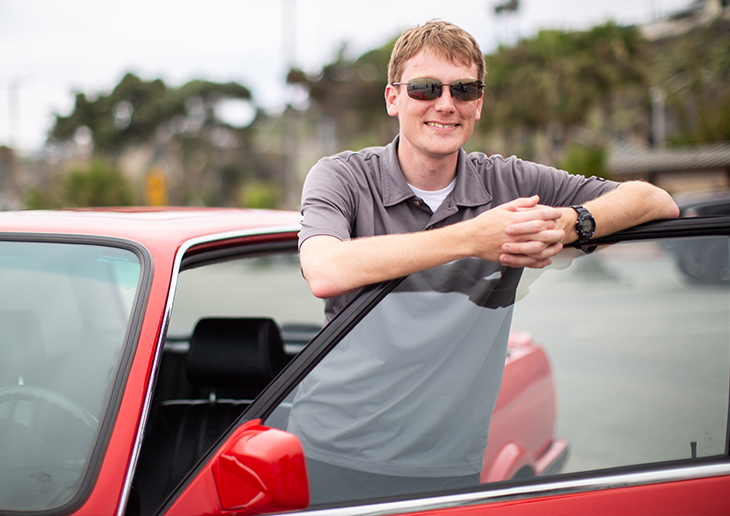Saddleback College’s Peter Lindstrom: A Date with Destiny. Student Success Profile
September 07, 2018

It all started with a car. A red BMW that was supposed to impress a girlfriend. A red BMW that turned out to be a lemon.
Today, Saddleback College graduate Peter Lindstrom could fix that car in his sleep. But back then, Peter didn’t know the difference between a carburetor and a carbohydrate. In need of advice, Peter went to his father, who gave him two options: sell the car or go to school to learn how to fix it. Peter chose the second option. The rest, as they say, is Carfax history.
When Peter started taking automotive technology courses at Saddleback, he expected to be up to his elbows in grease. Instead, he found himself up to his eyeballs in technology.
“Today’s cars need a different type of mechanic to fix them than those that fixed cars in the 70s, 80s, and even 90s,” explains Rajanpal Dhillon, Saddleback’s Senior Automotive Laboratory Technician and someone Peter credits with inspiring him to pursue his studies in automotive technology. “Peter was unique in that he was self-motivated from the start. He wanted to ask questions. He wanted to learn. Which is good, because today’s mechanics have to be good learners.”
Peter started taking classes on everything from auto engines to automotive machining. “The more I learned, the more I wanted to know […] By the end of the second year, I think every part of [that red BMW] was in a piece somewhere in some class.”
Over time, Peter became interested in not just how a car worked, but why it worked the way it did. “That’s why being at a community college is so great,” says Lindstrom. “I wanted to know why I was balancing wheels, so I got myself into an algebra class.”
Turns out, Peter was pretty good at algebra, which led to him taking more science and math classes. For Peter, career education was not just a chance to find a career, but also a chance to find himself. As Peter describes it: “I was really getting into it.”
As Dhillon explains, there’s a reason why Saddleback’s automotive tech program encourages students to also complete their general education requirements and a full Associate of Science degree: “Tomorrow’s mechanics need to know more than just how an engine works. They have to be electricians, they have to understand how hybrid fuel cells work, they have to know how to read complicated manuals. It’s not enough to be good with your hands anymore; automotive technicians have to be good with their brains too
Eventually, automotive technology department chair Cliff Meyer asked Peter if he wanted to team-teach an engines class. Peter, who had always loved the hands-on nature of his automotive courses, had only one question: “Do I get to play with the machines?” When Meyer said yes, so did Peter.
“One of the best things about the engine program is that students are basically required to bring in an engine, tear it apart, and rebuild it. You get engines of all kinds and students get to see how different engines use different approaches to solve the same problems.”
Dhillon emphasizes the hands-on nature of Saddleback’s program and prides himself on the many different types of state-of-the-art technologies to which students have access. “For instance, to learn about how electric cars work, we start by having students work on golf carts and then a 96-volt Switchlab 3-wheeler. They take those cars apart and put them back together and learn everything about how an electric car works. Finally, they see how this all comes together when they get to work on our 2017 Nissan Leaf and our 2012 Kia Optima Hybrid.”
Today, Peter works for CP-Carrillo, a company that makes pistons and connecting rods. Over the course of his time there, he has moved from the stock room all the way to the engineering department, where he now helps design connecting rods. Peter credits Saddleback and the practical training he received in automotive technology, math, and science with making his success possible. That, and the red BMW.
“I don’t think at the time my father meant it to be as influential as it ended up becoming,” says Peter. “The BMW project, working through Saddleback, gave me direction, a lot of direction […] I got into cars, wanted to know how they worked, got into math and science, then learned how to use that math and science to develop the parts that go back into the car. So, it’s one very coherent cycle. Without the program, without the car, I wouldn’t be here. I wouldn’t be doing any of this.”
Of all of Peter’s achievements, there’s one that stands out. Turns out, he did get the girl after all. In fact, he married her.




